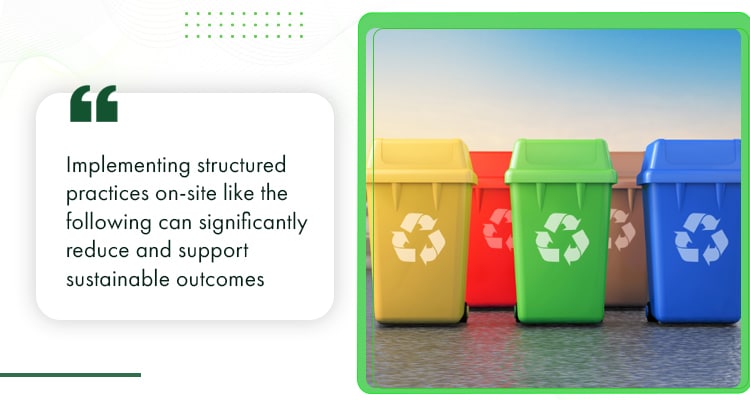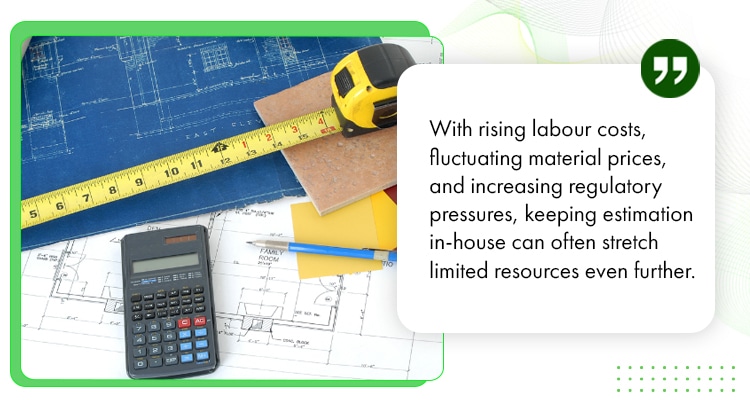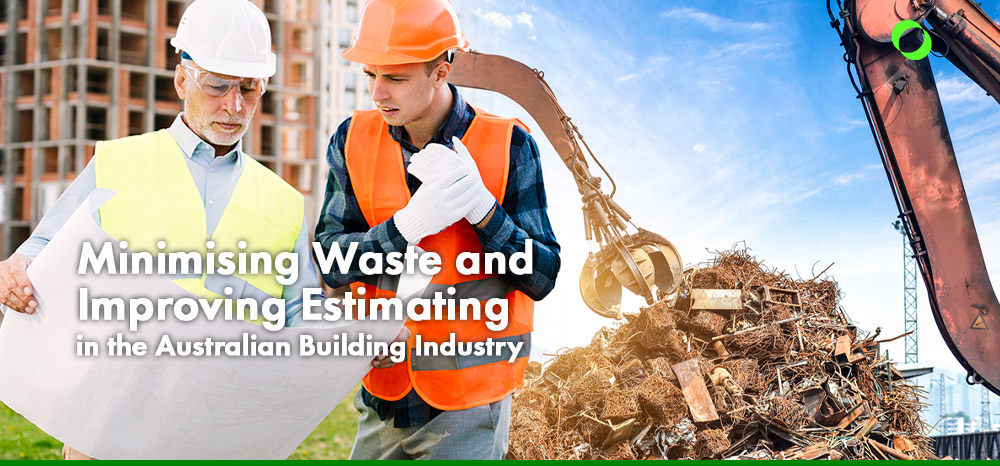The Australian building industry generates more waste than any other commercial sector. It’s responsible for over 27 million tonnes of waste each year.
Yet many project managers, builders, and estimators don’t realise that a large portion of this waste is preventable. Moreover, this waste stems from poor building project cost estimation, last-minute material changes, and inefficient project planning.
Minimising construction waste in Australia is now a strategic advantage, not just a regulatory requirement. Accurate cost estimating helps reduce waste and protect profit margins, yet many builders still rely on outdated, error-prone methods.
Read on to learn more about how to modernise your approach with smarter estimating practices, strategic outsourcing, and cutting costs while boosting sustainability.
Minimising Construction Waste in Australia
Waste in the construction sector is a bottom-line issue. Builders and project managers can take this as an opportunity to: reduce waste AND costs, improve margins, and enhance your business’s sustainability credentials.
Why Waste Minimisation Matters
Australia’s construction industry generates millions of tonnes of waste that end up in landfills.
It contributes to higher disposal costs and missed opportunities to reclaim materials, not to mention the disastrous environmental impact.
In addition, excessive waste increases project costs through over-ordering, poor material handling, and site inefficiencies.
Key Strategies for Reducing Waste
To reduce construction waste in Australia, builders and project teams can adopt practical, proven strategies:
- Reduce, Reuse, Recycle: Apply the 3Rs by cutting down on unnecessary materials, reusing formwork and offcuts, and recycling when possible.
- Modular Construction and Design for Disassembly: Prefabricated components lead to less site waste and easier disassembly at end-of-life.
- Use Recycled Materials. Integrate reclaimed steel, concrete, and timber into designs to cut costs and improve environmental impact.
On-Site Waste Management Practices

Implementing structured practices on-site like the following can significantly reduce and support sustainable outcomes:
- Creating Waste Management Plans: Identify and track all expected waste outputs from the start of the project.
- Installing Sorting and Recycling Stations: Set up easy-access points for separating materials like concrete, timber, and steel.
- Partnering with Local Construction Waste Recycling Facilities in Australia: Collaborate with recycling centres that accept your project materials and offer cost-effective disposal methods.
Training and Regulatory Compliance
A major factor in successful construction waste minimisation in Australia is the right education. Equip your teams with the proper training on waste management procedures and material handling.
Stay updated with Australian Standards and local council regulations to avoid fines and boost your site’s sustainability performance.
Benefits of Minimising Waste
Prioritising waste reduction can yield substantial returns:
- Lower landfill and haulage costs
- Stronger compliance with environmental legislation
- Positive branding through sustainable practices
- Reduced material purchasing and overordering
Understanding Construction Estimating Methods
Accurate estimates are the backbone of successful building projects.
In Australia, where market volatility, labour shortages, and regulatory compliance add layers of complexity, nailing down your numbers early on can mean the difference between profit and loss.
Thus, reliable construction estimating methods in Australia are essential for better budgeting, resource allocation, and client trust.
Types of Estimating Techniques

There are several tried and tested estimating methods used across the industry. Each one fits a different project type or phase:
- Square Metre Estimating. This approach can provide a quick estimation for early-stage budgeting. However, it’s not precise for complex or customised builds.
- Parametric Estimating. It uses data-driven variables like cost per unit (e.g., per door or bathroom). This method also helps predict costs using historical data and real-time pricing.
- Assemblies/Elemental Estimating. A technique that breaks down builds into systems like walls, roofing, or electrical needs. It is also ideal for modular builds and comparisons between design options.
- Detailed Quantity Takeoff. This method has two approaches. The manual approach is time-consuming, but still often used for smaller jobs, while the digital one produces accurate and efficient estimation with the assistance of software.
Tools of the Trade
Technology has transformed how builders approach cost estimation. Even small operations can benefit from:
- Professional Estimating Software. Tools like Buidxact, CostX, or Cubit provide real-time cost updates, visual takeoffs, and historical data integration.
- Spreadsheets and Custom Templates. For smaller or simpler jobs, tailored Excel templates can help manage scopes, track expenses, and reduce manual errors.
Best Practices in Estimating
To stay competitive and compliant, Australian builders can follow these proven strategies:
- Keep Data Up-to-Date. Market rates for materials and labour shift constantly—outdated input leads to underquoted jobs.
- Add Contingencies. Build in buffers (typically 5 to 15%) for price increases or unforeseen site issues.
- Learn from History. Consult and review past projects for realistic timelines, waste expectations, and pricing nuances.
Common Estimating Mistakes Made by Builders
Even experienced builders can fall into traps that inflate costs or destroy margins. Recognising and addressing these pitfalls early can protect your bottom line.
Scope and Cost Misjudgment
Lack of a clear project scope is one of the biggest culprits behind budget overruns.
When the scope shifts mid-project or isn’t properly defined from the outset, estimating tends to rely on guesswork.
Unverified takeoffs or third-party quotes also lead to under- or over-ordering materials, driving waste and labour costs up.
Regulatory and Overlooked Costs
Ignoring soft costs and hidden fees can be expensive. These often include:
- Permit application fees
- Environmental compliance charges
- Local council levies or zoning-related adjustments
Market and Project Dynamics
In a volatile construction market, sticking to outdated cost models is risky. Builders often:
- Fail to factor in rising material and subcontractor costs
- Underestimate variations in regional pricing
- Over-rely on one-size-fits-all cost models
Lack of Professional Expertise
Engaging experienced estimators—or outsourcing construction estimating in Australia to experts—helps avoid:
- Inaccurate quotes
- Missed deadlines
- Budget blowouts that damage client trust and/or diminish your bottom line
Outsourcing Estimation: Save Time and Reduce Costs
In an industry where time is money and margins are tight, outsourcing construction estimation has quickly become a smart strategy for Australian builders.

With rising labour costs, fluctuating material prices, and increasing regulatory pressures, keeping estimation in-house can often stretch limited resources even further.
That’s why more builders are exploring building cost estimation outsourcing as a practical way to improve accuracy, scale operations, and reduce building costs in Australia without compromising quality.
The Case for Outsourcing
When you outsource your estimating tasks, you’re not just delegating paperwork—you’re unlocking serious operational efficiency.
Builders report saving up to 80% of their time and 70% in labour and software costs by partnering with offshore or specialist local estimating providers.
You also gain access to advanced construction cost estimating methods in Australia—from detailed quantity takeoffs to digital modelling tools—without investing in training yourself or spending time and money to obtain expensive licenses.
Strategic Benefits for Builders
Here’s why smart builders are making the shift:
- Minimising Errors. Tap into experienced estimators with proven track records and systems in place to double-check their accuracy.
- Focus on Core Activities and Growing the Business. Free up time to win new contracts, monitor ongoing projects more effectively, and strengthen existing client relationships.
- Lowering Overhead. Say goodbye to ongoing costs related to training, software subscriptions, and full-time staff management.
Best Practices for Effective Outsourcing
Outsourcing works best when it’s built on transparency and collaboration. To get the most from your outsourced construction estimation partner:
- Align on Local Codes and Practices. Make sure your estimator understands regional building standards and the nuances of building project cost estimation in your area.
- Use Collaborative Platforms. Leverage cloud-based tools like Procore, Buildertrend, or Cubit for real-time updates, file sharing, and version tracking.
- Set Clear Expectations. Define scope, timelines, cost formats, and reporting protocols from day one to avoid confusion and rework.
Competitive Edge and Business Growth
In competitive environments, quick and accurate bids can mean the difference between winning and losing projects.
With outsourcing construction estimating in Australia, you can submit more proposals with greater confidence and more credibility.

Over time, this builds a more resilient and scalable business model, allowing you to grow without constantly adding to your overhead.
Outsourcing doesn’t just save you time on drawing up estimates. It positions your business for faster growth, fewer headaches, and sharper pricing strategies.
From Margin Pressure to Profit Potential
Today’s builders can’t afford to rely heavily on guesswork. If you’re serious about reducing construction waste and delivering better value to your clients—then it’s time to modernise your estimating approach.
Whether it’s the construction waste minimisation Australia needs or navigating common estimating mistakes builders still make, the shift toward smarter systems and outsourcing construction estimating with the help of virtual assistants could be the lever your business needs to scale.
Try to challenge yourself by auditing your current estimating practices. Then identify the gaps and explore what outsourcing these could unlock for your future.
If you’re ready to save time, reduce building costs, and bid with greater precision—then it’s time to move forward to the next step!
- Want FREE AI Prompts for Different Areas of Your Business? Check out these 100 AI prompts.
- Curious About How to REDUCE Overhead Costs? Learn more here.
- If you’re ready to experience the full advantages of working with a top global team, check out our 1,000 fully vetted and highly talented staff here.
Darren Aragon is a multifaceted writer with a background in Information Technology, beginning his career in research at Pen Qatar and transitioning through customer service to a significant role at Absolute Service, Inc. His journey into freelance writing in 2021 has seen him excel across various niches, showcasing his adaptability and deep understanding of audience engagement.




















